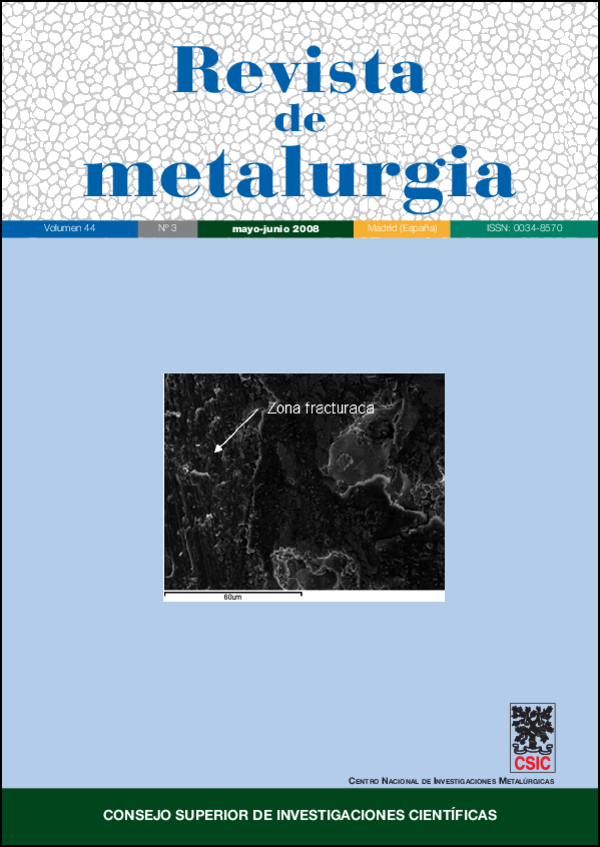Distribution behaviour of selenium, cobalt, molybdenum and cadmium in copper smelting process under dust recirculation
DOI:
https://doi.org/10.3989/revmetalm.2008.v44.i3.116Keywords:
Copper smelting, Minor elements, Selenium, Cobalt, Dust recirculationAbstract
Usually dust generated from copper smelting in Chile contains high concentrations of copper and arsenic, but also other metals of considerable value and some environmental interest such as selenium, cobalt and molybdenum. It is desirable to understand the behavior of those elements when the smelting process operates with dust recirculation. In this study, the effect of dust recirculation to smelting process on the distribution among the matte, slag and gas phases were evaluated as a function of matte grade, amount of recirculated dust, oxygen enrichment and temperature. Experimental results show that selenium can be concentrated at high matte grade ranges and high oxygen enrichments in blowing gas. However, the result suggested that high recirculation amounts to smelting process are not feasible because it increases the minor metal losses.
Downloads
References
[1] H. Sano, V. Montenegro y T. Fujisawa, Proc. 6th Int. Copper-Cobre Conf., Volume VI, Sustainable Development, HS&E and Recycling, 2007, Toronto, Ontario, Canada, pp.141-149.
[2] J. Osorio, M. Mella. M. Maldini y M. Herrera, Proc. Hydroprocess, Arturo Prat University, Iquique, Chile, 2006, pp. 387-400.
[3] S. Mikhail, A. Webster y J. Laflamme, Can. Metall. Q. 28 (1989) 241-249.
[4] T. Kho, D. Swinbourne y T. Lehner, Metall. Trans. B 37 (2006) 209-214. doi:10.1007/BF02693150
[5] H. Henao, K. Yamaguchi Y S. Ueda, Proc. TMS The Minerals, Metals & Materials Society, 2006, San Diego (EEUU).
[6] M. Nagamori Y P. Chaubal, Metall. Trans. B 13 (1982) 331-338. doi:10.1007/BF02667748
[7] A. Yazawa, Proc. 28th Cong. IUPAC, Vancouver, 1981, pp. 1-21.
[8] C. Gonzalez, R. Parra, A. Klenovcanova, I. IMRIS Y M. SANCHE, Scand. J. Metall. 34 (2005) 143-149. doi:10.1111/j.1600-0692.2005.00740.x
[9] A. Yazawa, Can. Metall. Q. 8 (1970) 257-261.
[10] A. Westland y A. Webster, Can. Metall. Q. 29 (1990) 217-225.
[11] N. Choi y W. Cho, Metall. Trans. B 28 (1997) 429-438. doi:10.1007/s11663-997-0109-0
[12] P.J. Mackey, Can. Metall. Q. 21 (1982) 221- 260.
[13] K. Itagaki, M. Hino, A. Zakeri y D. Mendoza, Copper 2003, Vol. 4, Pyrometallurgy of Copper, Ed. C. Diaz, C. Landolt and T. Utigart, Santiago-Chile 2003, pp. 427-436.
[14] H. Mendoza, A. Luraschi, G. Riveros y M. Cerna, Copper 95, Vol. 4, Pyrometallurgy of Copper, Ed. W.J. Chen, C. Diaz, A. Luraschi and P.J. Mackey (Canadian Institute of Mining, Metallurgy and Petroleum), Quebec, 1995, pp. 281-299.
[15] Y. Kawai Y y. Shiraishi, Handbook of Physicochemical Properties at High Temperatures, The Iron and Steel Institute of Japan, 1988, pp. 73-91.
Downloads
Published
How to Cite
Issue
Section
License
Copyright (c) 2008 Consejo Superior de Investigaciones Científicas (CSIC)

This work is licensed under a Creative Commons Attribution 4.0 International License.
© CSIC. Manuscripts published in both the printed and online versions of this Journal are the property of Consejo Superior de Investigaciones Científicas, and quoting this source is a requirement for any partial or full reproduction.
All contents of this electronic edition, except where otherwise noted, are distributed under a “Creative Commons Attribution 4.0 International” (CC BY 4.0) License. You may read the basic information and the legal text of the license. The indication of the CC BY 4.0 License must be expressly stated in this way when necessary.
Self-archiving in repositories, personal webpages or similar, of any version other than the published by the Editor, is not allowed.
















